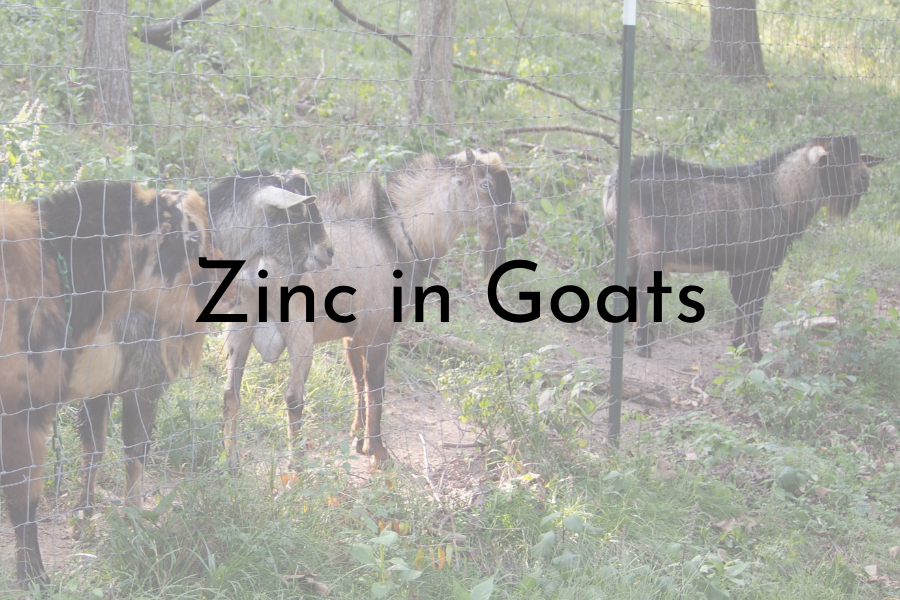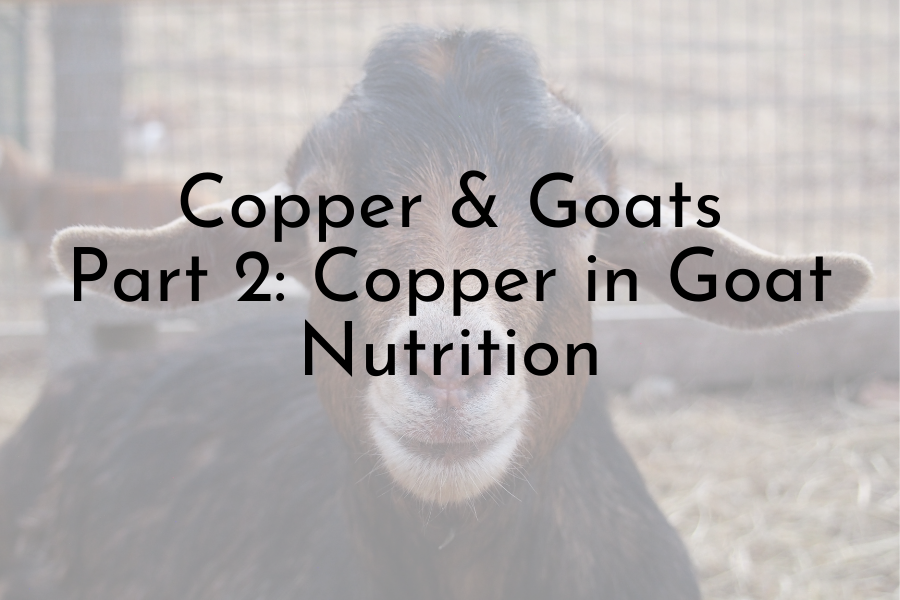Part 1: The Nutritional Wisdom of Ruminants
- Kendra R. Shatswell

- Jul 22, 2020
- 6 min read
Updated: Jan 2
𝐀 𝐁𝐫𝐢𝐞𝐟 𝐎𝐯𝐞𝐫𝐯𝐢𝐞𝐰 𝐨𝐟 𝐂𝐨𝐩𝐩𝐞𝐫 𝐢𝐧 𝐒𝐦𝐚𝐥𝐥 𝐑𝐮𝐦𝐢𝐧𝐚𝐧𝐭 𝐍𝐮𝐭𝐫𝐢𝐭𝐢𝐨𝐧, 𝐏𝐚𝐭 𝐂𝐨𝐥𝐞𝐛𝐲’𝐬 𝐌𝐢𝐧𝐞𝐫𝐚𝐥 𝐌𝐢𝐱, 𝐚𝐧𝐝 𝐭𝐡𝐞 𝐍𝐮𝐭𝐫𝐢𝐭𝐢𝐨𝐧𝐚𝐥 𝐖𝐢𝐬𝐝𝐨𝐦 𝐨𝐟 𝐑𝐮𝐦𝐢𝐧𝐚𝐧𝐭𝐬
I love learning about goats. When learning about mineral relationships, I took a tumble down the rabbit hole. What started as some rambling on my personal profile is now planned to become a series of posts here on the farm page and articles for the blog and the KGBA newsletter.
When learning about any subject, it is important to consider the source – try to find credible sources when conducting your own research (which I strongly encourage). Primary sources include scholarly works like research studies and case studies – these provide data and methods to support claims. Credible secondary sources include textbooks, encyclopedias, journal articles, and reviews - these should reference primary sources. When reading goat husbandry books, take note of who wrote it, what his or her credentials are, and if the statements are backed by verifiable sources. I will do my best to provide every credible learning source I can, as well as note when something is purely my own observation, speculation, opinion etc…
To be blunt, I hate seeing Pat Coleby’s mineral mix recommended without folks understanding a few critical things about it AND the herd they are recommending it to. For fans of the program, it is nothing personal against you, promise.
𝐹𝑖𝑟𝑠𝑡 𝑎𝑛𝑑 𝑚𝑜𝑠𝑡 𝑖𝑚𝑝𝑜𝑟𝑡𝑎𝑛𝑡𝑙𝑦, 𝑦𝑜𝑢 𝑚𝑢𝑠𝑡 𝑢𝑛𝑑𝑒𝑟𝑠𝑡𝑎𝑛𝑑 𝑡ℎ𝑎𝑡 𝑃𝑎𝑡 𝐶𝑜𝑙𝑒𝑏𝑦 𝑙𝑖𝑣𝑒𝑑 𝑖𝑛 𝑎𝑛 𝑖𝑛𝑐𝑟𝑒𝑑𝑖𝑏𝑙𝑦 𝑐𝑜𝑝𝑝𝑒𝑟-𝑑𝑒𝑓𝑖𝑐𝑖𝑒𝑛𝑡 𝑎𝑟𝑒𝑎 𝑜𝑓 𝐴𝑢𝑠𝑡𝑟𝑎𝑙𝑖𝑎. What saved her herd and made it thrive might kill yours unless your soil and forage conditions are similar. Yes, some farms need more copper supplementation than others but unless you know what your copper levels ARE in your herd - liver analysis! - and what levels and antagonists you are dealing with, you can't have a clear picture of the requirements. How do you do that? A lot of testing – water, forage, hay, soil, feed.
Here are two good maps of the copper ppm levels in the soil in the United States. One is more detailed than the other. Both are older, but give you an idea. The best way to determine copper levels is to get your own forage, soil, and water tested! And not just for copper, either. You must determine the level of antagonists, as mentioned earlier. Two of the most important copper antagonists to test for are molybendum and sulfur – more on mineral relationships later. https://pubs.usgs.gov/pp/1270/pdf/PP1270_508.pdf
(page 38)
(page 85)
𝑀𝑖𝑛𝑒𝑟𝑎𝑙 𝑏𝑎𝑙𝑎𝑛𝑐𝑒𝑠 𝑎𝑛𝑑 𝑠𝑜 𝑚𝑎𝑛𝑦 𝑜𝑡ℎ𝑒𝑟 𝑓𝑎𝑐𝑡𝑜𝑟𝑠 𝑎𝑓𝑓𝑒𝑐𝑡 𝑏𝑖𝑜𝑎𝑣𝑎𝑖𝑙𝑎𝑏𝑖𝑙𝑖𝑡𝑦. Mineral imbalances caused by chronic copper toxicity are being researched more. As of right now, one herd I am acquainted with experienced huge losses due to copper, molybendum, and zinc imbalances. Ratios are as important as amounts! She has had some very interesting posts on the subject at Red Horse Valley LLC – she’s done SO much testing and research on the subject of copper and mineral imbalances in goats and has been kind enough to share it and answer questions! I will detail more of that later, but please do check it out for yourself, too.
Copper is a very important trace mineral, but the requirements are not well-established and are highly variable. Copper is cumulative and not excreted well in ruminants. Excess from all sources – feed, hay water, forage, medicines, minerals – is stored in the liver. Goats typically tolerate copper better than sheep but that doesn't mean they always *need* it in such high levels. Copper toxicity can be acute or chronic. More about the role of copper and signs of deficiencies and toxicities in an upcoming piece. (3)
Something else that concerns me about the Pat Coleby mix is that it has almost NO zinc in it. It was this copper to zinc imbalance in my own herd that led me to begin seriously researching mineral relationships in the first place. My own herd has experienced zinc deficiency due to copper to zinc imbalance.
I know of one herd that was on the Pat Coleby program where this became a serious issue that led to goats eating raw beef. You read that right. GOATS. EATING. RAW BEEF. More on that nightmare later.
The Coleby mix also recommends one part kelp to provide all other minerals, but after researching kelp, I found that the mineral levels can be incredibly variable based on the species, the harvest time, the water temperature etc… It could also require large volumes of kelp to meet the daily requirements of some trace minerals such as selenium, which could be problematic in herds with known selenium deficiencies – more on kelp in an upcoming article.
Pat Coleby recommends both a program where minerals are offered in small amounts daily and a cafeteria-style program where animals are offered all mineral components free choice. A cafeteria-style mineral program is based on the idea that goats are nutritionally wise and can select what they need and when they need it. In my research, Dr. Fred Provenza and Dr. Richard Holliday are the most avid champions of free-choice, individual mineral feeding and nutritional wisdom. Their observations and studies on the topic illustrated that the animals did not seek out certain minerals until they were DEFICIENT, sometimes severely deficient, or imbalanced. 𝑇ℎ𝑖𝑠 𝑚𝑒𝑎𝑛𝑠 𝑡ℎ𝑎𝑡 𝑟𝑢𝑚𝑖𝑛𝑎𝑛𝑡𝑠 𝑒𝑎𝑡 𝑡𝑜 𝑐𝑜𝑟𝑟𝑒𝑐𝑡, 𝑛𝑜𝑡 𝑝𝑟𝑒𝑣𝑒𝑛𝑡 𝑑𝑒𝑓𝑖𝑐𝑖𝑒𝑛𝑐𝑖𝑒𝑠. (1) (4) (5)
How DO ruminants learn what to eat? Here’s what we’ve learned so far. Taste is the most important factor in deciding, followed by texture and odor. Studies have shown that ruminants learn what to eat through social learning (observing and copying dams and herdmates) as well as from biological feedback after consuming those foods. 𝑇ℎ𝑎𝑡 𝑚𝑒𝑎𝑛𝑠 𝑡ℎ𝑎𝑡 𝑡ℎ𝑒 𝑎𝑛𝑖𝑚𝑎𝑙 𝑙𝑒𝑎𝑟𝑛𝑠 𝑝𝑟𝑖𝑚𝑎𝑟𝑖𝑙𝑦 𝑡ℎ𝑟𝑜𝑢𝑔ℎ 𝑡𝑟𝑖𝑎𝑙 𝑎𝑛𝑑 𝑒𝑟𝑟𝑜𝑟. (5) (6) If it eats this particular shrub and experiences negative consequences (rumen upset for example) the animal will then, in theory, associate the taste of that shrub with the rumen upset and not eat it again, or at least not eat large amounts of it. Perhaps the smell and sight alone will be enough to recognize the offending plant. It is my concern that, in this trial and error method, some things might be too toxic to get a second try - this is why I personally would not try the free-choice copper sulphate in the PC mix.
Animals do not “instinctively” recognize nutrients, not even sodium. Sodium is dissolved and absorbed so quickly it does appear that the animal recognizes it instinctively. In early studies on nutritional wisdom, sodium was mixed in every mineral that was offered cafeteria-style. Proponents of nutritional wisdom and cafeteria-style mineral programs note this as a flaw and argue that it made it impossible for the animal to “associate feedback from the mineral with its flavor.” – On Pasture: Can Animals Figure Out What Minerals They Need. (5) 𝑁𝑜𝑛𝑒𝑡ℎ𝑒𝑙𝑒𝑠𝑠, 𝑡𝑜 𝑑𝑎𝑡𝑒, 𝑡ℎ𝑒𝑟𝑒 𝑖𝑠 𝑛𝑜 𝑒𝑣𝑖𝑑𝑒𝑛𝑐𝑒 𝑟𝑢𝑚𝑖𝑛𝑎𝑛𝑡𝑠 𝑐𝑎𝑛 𝑟𝑒𝑐𝑜𝑔𝑛𝑖𝑧𝑒 𝑚𝑖𝑛𝑒𝑟𝑎𝑙𝑠 𝑜𝑡ℎ𝑒𝑟 𝑡ℎ𝑎𝑛 𝑐𝑎𝑙𝑐𝑖𝑢𝑚, 𝑠𝑜𝑑𝑖𝑢𝑚, 𝑎𝑛𝑑 𝑝ℎ𝑜𝑠𝑝ℎ𝑜𝑟𝑢𝑠. Perhaps they can – this complex subject needs studied more! Here's a good study on the subject (2)
One of my favorite articles on the subject is about phosphorus-deficient steers eating RABBITS. Check out link 1 below.
Now, I think that nutritional wisdom is a fascinating subject worth studying more. There is obviously evidence that ruminants can select what they need in some instances. Am I going to jump in and give my goats free choice individualized minerals (Pat Coleby mix or other formulas) based on so little evidence? No. Why? Because I always question the nutritional wisdom of goats when I see them repeatedly eating things like hemlock and azaleas and cigarette butts and animal crackers and my license plate sticker (looking at you, Noodle!) – you get the idea. I believe that, perhaps too often in the case of goats, palatability and curiosity win over need.
Even Dr. Holliday notes this – “I realize mainstream nutritionists tend to downplay or totally reject the idea that animals can self-regulate their nutritional needs. I admit that this ability may not apply to all situations and to every type of feed. Some feed items (grains and concentrates) may be so tasty that most animals would overeat if fed free choice.” (4)
Personally, I would much rather get a mineral mix that has things in close to the "right" ratios for the known shortcomings and excesses of minerals in my soil and forage and tweak the formula as needed, even on an individual basis. I would much rather PREVENT a deficiency than rely on the animals’ possible ability to CORRECT for one.
Yes, this was lengthy and the others will likely be, too, but this is a fascinating, complex series of subjects. If you hung in there to the end, thank you! *let me know if a link isn't working!* #HeftyGoatHollerFarmLearning
𝐈𝐧 𝐭𝐡𝐞 𝐮𝐩𝐜𝐨𝐦𝐢𝐧𝐠 𝐢𝐧𝐬𝐭𝐚𝐥𝐥𝐦𝐞𝐧𝐭𝐬: What does copper DO and what minerals interact with copper? More on Pat Coleby’s mix, including the copper ppm of a 50lb bag of the mix compared to commercial mineral mixes. Mineral analysis and factors affecting the mineral levels in kelp. Does fishtail = copper deficiency? – the answer will probably surprise you. Minerals and vitamins that affect goat hair and common causes of hair loss.
Sources - 1 - https://onpasture.com/2013/08/12/deer-eat-birds/?fbclid=IwAR1SMLTEbnPi_bmNGOTWlaN-8s-9LQeG0raSMe3t7FNNDj_0AWLrdwYJAoo


